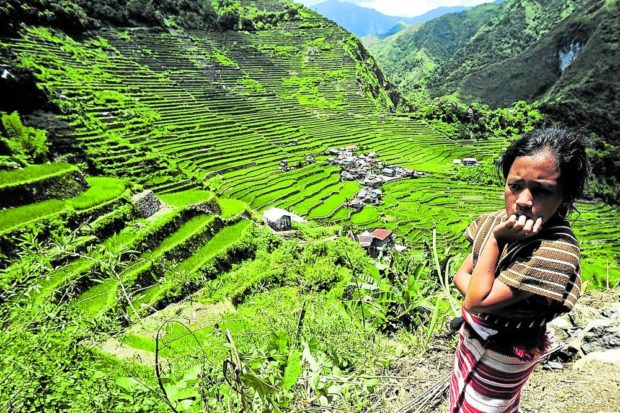Ifugao Rice Terraces land on another ‘protection’ list

STILL MAKING WONDERS The world-famous Cordillera landscape keeps getting international attention amid increasing climate threats. —EV Espiritu
MANILA, Philippines — Communities that depend on the Ifugao Rice Terraces for their livelihood will receive support from Canada-based Manulife Financial Corp. and National Geographic (NatGeo) Society, which have included the famous Cordillera landmark in a list of 10 heritage sites that must be protected from the impact of climate change.
Eight others on the list, drawn up under the “Preserving Legacies: A Future for Our Past” initiative, are also on the World Heritage List of the United Nations Educational, Scientific and Cultural Organization (Unesco).
These are Petra (Jordan); Angkor Archeological Park (Cambodia); Historical Mosque City of Bagerhat (Bangladesh); Nan Madol (ruins in Micronesia); Levuka (port town in Fiji); Koutammakou, the Land of the Batammariba (Togo and Benin); Sceilg Mhichil Island (Ireland); and the Port, Fortress and Group of Monuments at Cartagena (Colombia).
The 10th entry is the Border Field natural beach and coastal habitat which straddles the border between the United States and Mexico.
Local threats, responses
In a joint statement, Manulife and NatGeo said the project could help safeguard these historic and culturally significant sites from the impact of climate change and protect the physical and financial well-being of the communities that rely on them for livelihood.
Article continues after this advertisementUnder the project, it is hoped that the communities can better visualize climate threats on a local scale and be trained in scientific mitigation efforts.
Article continues after this advertisementThe initiative is led by National Geographic explorer Victoria Herrmann and is connected to Manulife’s Impact Agenda, which was launched in the Philippines earlier this year with Gawad Kalinga, Corazon Sanchez Atayde Memorial Foundation and Haribon Foundation as partners.
“[O]ur ambitious approach to addressing this critical issue will not only lead to tangible protection of cultural heritage sites; it will be the game changers needed to increase access to heritage adaptation and transform conservation as a field to meet the challenges of a climate-changed world,” Herrmann said.
Rahul Hora, Manulife Philippines president and chief executive, said the company wants to contribute to efforts mitigating climate change risks to people’s lives and livelihood.
Through mentoring programs and educational materials, the project hopes to teach communities how to turn scientific knowledge into actionable management plans for the protection of heritage sites.
Using local weather data, for example, climate models can be developed to assess how much flooding, heat, sea level rise and changing seasonality could threaten the communities in different scenarios. This would enable their leaders or site managers to know what climate impacts to anticipate and plan for.
‘Unparalleled beauty’
The Ifugao Rice Terraces have five terrace clusters within the province that were included on the World Heritage List in 1995.
Unesco described the terraces in Batad and Bangaan in Banaue, Hungduan, Kiangan, and in Mayoyao as “a living cultural landscape of unparalleled beauty.”
Built more than 2,000 years ago and preserved through generations, the terraces, Unesco said, can be considered an example of how an ancient civilization can survive the various challenges of modernization.
Marijuana plantation?
In 2001, the terraces also landed on the World Heritage Committee’s list of endangered heritage sites. They were removed from the list in 2012 after the government gave assurances that the threatened sections would be repaired.
Earlier this month, Ifugao Gov. Jerry Dalipog said abandoned and worn-down terraces may be suitable for growing medical marijuana should cannabis cultivation be legalized in the country.
Dalipog was then reacting to the idea of using the terraces for growing “weed,” a proposal that cropped up during a Senate hearing on a medical marijuana bill.